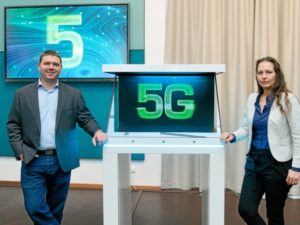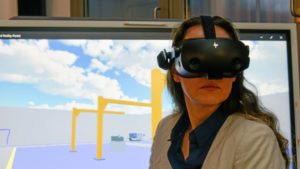Adlershof Technology Park tests with 5G
Adlershof tests with 5G
Berlin. No one has to drive out to see the factory floor and discuss how best to position the machines. Such meetings, like meetings of construction planners, are increasingly being moved into the virtual world. Avatars move through the artificial space as the alter egos of the technicians or architects.
This type of virtual collaboration is made possible by the super-fast fifth-generation Internet, 5G. But what individual mobile communications providers offer private individuals under this label has little to do with what technology professionals will need in the future. To test the use of 5G, Berlin’s leading technology park in Adlershof has now set up the most powerful campus network within a radius of 1,000 kilometers, as project manager Lukas Becker proudly reports.

On one square kilometer of campus, the 5G network is available outside and inside.
5G is now available over one square kilometer on the campus area around Rudower Chaussee. Initially it only ran outside, but now numerous indoor rooms are also equipped with the special routers. Another advantage of the technology is that not all buildings have to be connected with fiber optic cables.
The main transmission tower is located on the eight-story building of the Institute of Software Technology of the German Aerospace Center (DLR) on nearby Albert-Einstein-Strasse. In Forum Adlershof, the state-owned park operator Wista has set up a show room where applications can be presented and tried out.
Computer-generated worlds can be explored in the show room using special glasses.
With the help of various virtual reality goggles, visitors can enter parallel digital universes, such as the Metaverse, which is being developed by the Facebook company Meta at enormous expense. Closer to practical use are the virtual factory floors, where you can move plants back and forth at the touch of a button. Many products come from the computer game sector and are now being transformed into the industrial sector.
It is possible to integrate up to one million sensors into the system on this one square kilometer of the 5G campus, reports Becker. Autonomous driving immediately comes to mind as a possible application. Data transfer is still delayed by 50 to 70 milliseconds, he says. With 5G, data would be transported in just three milliseconds. “Faster than the blink of an eye,” says Becker. Ten gigabites of data could be transmitted per second without cables. In the showroom, students have already determined how much slower a self-driving car comes to a halt under 4G than under 5G.

With the 5G Campus network, the Adlershof site climbs to the next level.
Wista has invested two million euros to give local companies and institutes the chance to gain experience with 5G and take the location to the next level. This includes realizing that many business models work without such a real-time network. “You don’t need 5G for email and Netflix,” Becker says. And even large amounts of data that don’t require real-time transmission can be better sent over a conventional fiber-optic cable. “We’re offering a construction kit here that you can draw from,” Becker says, “5G is a building block.”
The campus network will also be about learning for whom it makes sense to build 5G, says Jenny Orantek. She works for Adlershof-based software company X-Visual, which produces operator software for industrial and other technical systems. Orantek also oversees the MR4B network, which is funded by the Senator of Economics and links companies, institutes and universities.
Medium-sized companies and craftsmen in particular are to test the possibilities of 5G
The acronym stands for “Mixed Reality for Business.” It is about making artificial intelligence and systems usable for business that combine computer-generated environments with the natural perception of the user. The coordinator says the network focuses less on corporations and more on medium-sized companies and craftsmen from the region. Large companies could and do build their own 5G networks at their sites.
In Adlershof, on the other hand, they want to enable small businesses to be prepared when customers say they have such a network and ask how the suppliers’ applications run in 5G conditions. After all, many practical applications are likely to relate to the repair and maintenance of machinery. 5G is also suitable as a basis for controlling robots in sensitive laboratories and clean rooms, where as few people as possible should be allowed in.

The goal is a center of excellence for virtual reality and artificial intelligence in the region
“We have to make the added value clear to medium-sized companies,” says Jenny Orantek. Over the next few years, the network is to become a center of excellence for virtual reality, augmented reality – combining virtual and real elements in an environment – and artificial intelligence.
It could also make sense for craft businesses to look into the possibilities of 5G, says Wista project manager Becker. The first companies are already doing so, he says, especially electrical contractors who want to service switch boxes virtually, for example. The application of such modern technologies could be an argument for attracting young talent and making the skilled trades as a whole more attractive to ambitious young people.
Overall, the areas of application for 5G would increase in the coming years, believe the experts in Adlershof. After all, they say, every robot consists of sensors, generates more and more data. “5G is accelerating the availability of new technologies,” says Jenny Orantek.
Read the full article on the Berliner Morgenpost website here!